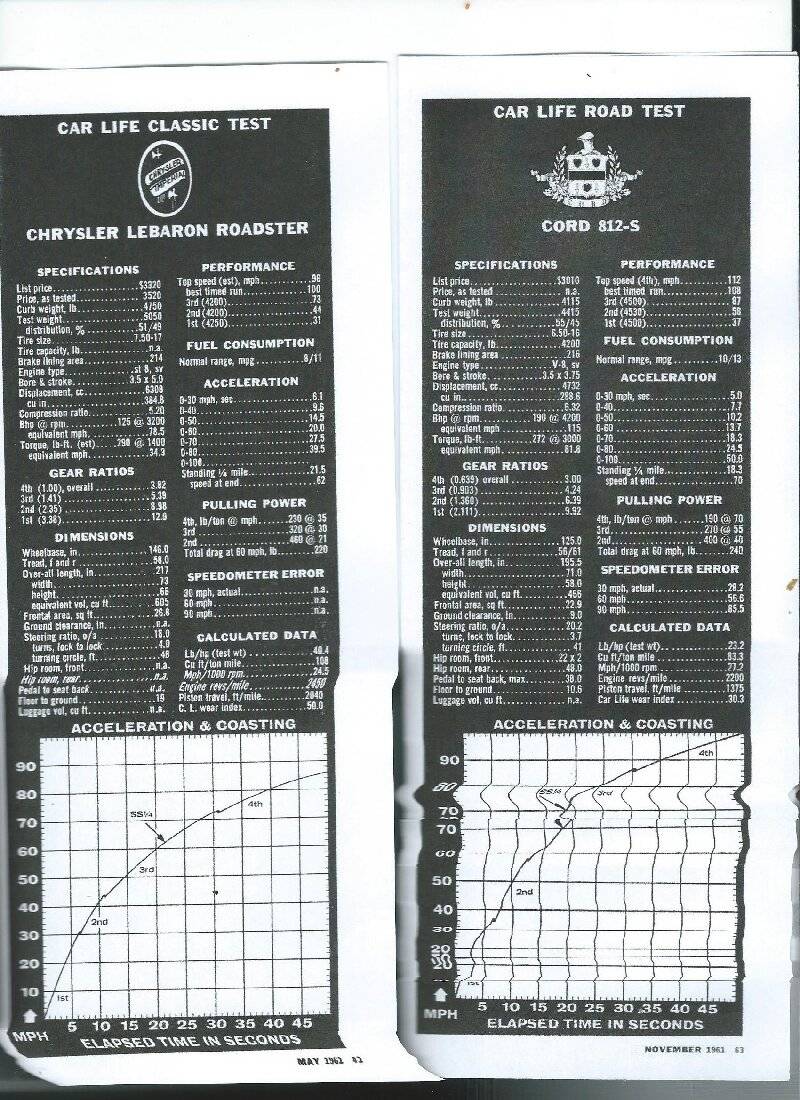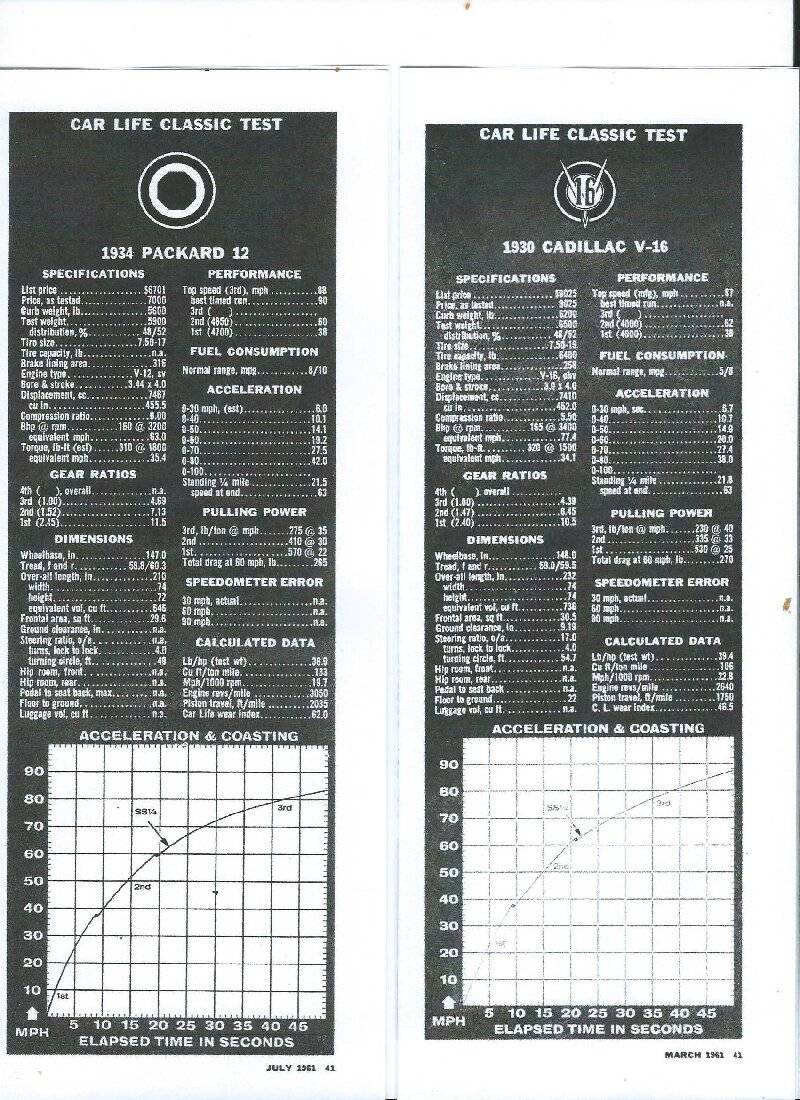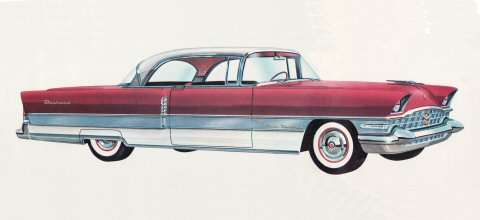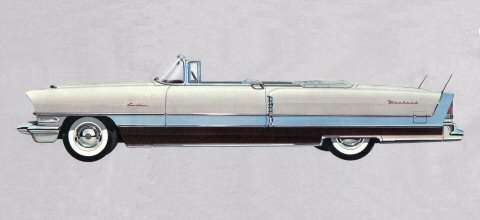|
Re: Top Speeds
|
||||
|---|---|---|---|---|
|
Home away from home
|
Good question. Many of us would like to see sanctioned top speed results, per AAA for one.
I've seen various mentions in credible sources of 78-80 mph for the 1937-39 Six, including Packard's own "Promotional Pointers," comparing that model with a Buick Model 40 (renamed Special for 1940), including crowing over another inch of seat width, seat height, legroom, brake or driveline feature, in which Packard ceded the junior Buick "four miles an hour faster." At 16 minutes into the below, Packard claims 104 mph for the new 1940 One-Sixty sedan on their Proving Grounds' banked oval, supposedly the world's fastest paved track through the 1930s at least, permitting higher speeds than Brooklands or Indy, etc., but the below promo is hokey,only shows how the Company forgot, as with hokum like a '40 junior print ad heralded "It's happening on a thousand Main Streets," that people want what the couple in the house on the hill have, not what their neighbors aspire to. How many ads do you see containing the adjective "downscale?" No mention if that "104 mph" is confirmed or strictly, as the promo suggests, speedometer reading, which is no better than ballpark: FIXED! 1940 Packard Motor Car Company Film - Quality First Runtime: 18:10 Packard later ran an ad for the new '41 1/2 Clipper (introduced in April, because used car inventories traditionally lowest that time of year; same reason the Mustang debuted 1964 1/2, both new models turning out to be bellringers) showing it traveling X amount further on the same amount of gas as an old/traditional bodied '41 120, thanks to streamlining. Off subject, but the 1949-50 bathtub Nashes had the lowest coefficient of drag of any concurrent domestic car, Packard's porky 1949-50 Custom Eight among them. Not much help, but neither am i tendering hear tell or my uncle said. I have top speed results of all 1949-50 domestic cars via John Bond, Road & Track's founder, tech editor, a degreed engineer who allowed no BS, but this won't conclusively answer your prewar Six question. In aeronautics, cruising speed is that which returns greatest economy of operation. There is no single percentage of top speed for all automobiles, because of the wide variance in quality, bearing type, engine design and breathing capability, gearing, CD ratings. For example, circa 1950, 2,500 ft. per minute widely accepted as safe sustained maximum piston speed, whether low-priced car or new Bentley Continental. We've seen breathless gush over the latter's "120 mph cruising speed," for example, when 116 possible on stringent manufacturer's test only with rear seat and spare tire removed, tires pumped up to 50 psi (very dangerous). Similarly, you'll read about Packard Twelves able to reach 100 mph. Their tallest and rare optional rear axle ratio, 4.06:1, in a roadster with rear mounted spare instead of sidemounts, top in place, no outside rear view mirrors or other effluvia, might return 90+. A '40 Hudson Eight sedan, certainly with overdrive, Hudson's first year for that feature, gave an AAA-recorded 93 mph at Bonneville, fastest US car that year, according to article in that year's trade monthly, Automotive Industries. But perhaps Packard, Cadillac, Buick didn't bother to send a car. Finding credible absolute speed in non-sporting cars is difficult because it wasn't an issue to many people, nor necessary in advertising. For example, did you ever see a claimed top speed given in a late '60s, '70 Olds 98, Buick Electra 225, Cadillac DeVille or Ford LTD advertisement? When England's respected road tester/auto writer John Bolster trialed the new and pudgy '60 Jaguar XK-150S, it offering same engine tune as the coming year's new E-Type (there's no such thing as an "XKE," that's 'Murican speak, and the E did not go "150 mph" unless rigorously tweaked with the tallest available axle), they even removed the antenna. May this provide perspective, and given the effort Howard HH56--and OwenDyneto, Tim Cole and only a couple others -- put into their helpful, accurate replies most here take for granted, yet do not bother reciporocating, might we make rule to delete those posts laden with misspelt words? This is a site for the preservation, maintenance, rebuilding, enjoyment of Packards, a company once advertising in National Geographic, Literary Digest, the New Yorker. If most here gathered have their cars fettled to the level of their online effort or erudition, i wouldn't ride two blocks in, let alone drive one of them. We get it. The Branson/Dollywood/Fox set likes Packards, too. So be it. But let's have some decorum and effort. Kev's knocked himself out providing a stellar site. We should all do no less contributing in kind. If too lazy to consult a dictionary, try Spell Check, since most here live online, not in their garages or behind the wheel. Finally, we all know why old cars geared like tractors, so let's not spin our wheels rehashing that. John Fogarty, you also asked for 1937-39 120 top speed. Add four of five mph to the Six figures.
Posted on: 2023/2/14 21:08
|
|||
|
||||
|
Re: Top Speeds
|
||||
|---|---|---|---|---|
|
Home away from home
|
I know zero about 'sanctioned' top speeds for Packards and I have not seen or read any Packard info relating to same. I do think, if it was anything back then, like it is today, one would probably not want to be driving their vehicles as purported by advertising anyway! I watch TV ads today of cars, SUV's and trucks being driven offroad and in challenging conditions and can only conclude that if one drove one's new Ford F150 say, like they do in the ads, it wouldn't last a month!!
That being said, I am a firm believer that common sense and one's ears are the best arbiters of how, and how fast to drive any vehicle. With our Packards, there are more than one rear end ratio out there for any given engine and that definitely affects top speed, and tachs are quite rare, (in the stock cars at least) so I believe listening to the engine is the best gauge. It's not hard to 'hear' when a mill is being over-revved and sustained speed and burst speed are two different things. In my '39 Six I find I can run it up to 55-60 in short bursts but 50-55 is a safe and comfortable RPM and speed to operate at, on the highway. I doubt the roads back in the day allowed much more than that anyway, so they were likely designed for that kind of speed/use. And SU8overdrive, while I appreciate your desire for better accuracy, composition and spelling on the site, I think we have to take into consideration that we have Packard fans from all walks of life and various levels of literacy on the site, and Oxford (or maybe in your case, Harvard) English just 'ain't gonna happen'! We can all be reminded to give our posts a read before hitting the 'submit' button and that would help a lot. (like on your post: I presume you meant 'why old cars are geared like tractors' and 'add 4 or 5 miles' - easy oversights to commit, but we know what you meant!) Chris
Posted on: 2023/2/15 16:49
|
|||
|
'If you think you can, or you think you can't - you're right!' Henry Ford.
1939 Packard Six, Model 1700 |
||||
|
||||
|
Re: Top Speeds
|
||||
|---|---|---|---|---|
|
Home away from home
|
Right. The dictum was to not "have your foot in the carburetor;" to not pull too much manifold pressure, or lug the engine.
Better to err on slight over rev than lugging, a free running engine happier, returning better fuel mileage. Ain't requesting "Oxford/Harvard English," whatever that may be. Only enough thought and consideration that posters proof before clicking submit. Every household should have a dictionary, hence the wonder as to how much care goes into maintaining some of these survivors. The missing "are" baffling you extraneous, purposely omitted, even as certain nervous tics and gingerbread on our cars. Less is more lost on many domestic old car owners, as much as "weight is the enemy." A longtime friend who's owned 70+ Packards, junior and senior, pre- and postwar, since he in high school, i upon tricycle, is on his fourth or so Darrin, his swan song black, black top, blackwalls, basic bale ornament, gray interior, naught else. You really "see" the car. Was decrying the "One Eighty" script below the front of the hood on '41 & '42 Darrins, which some think overblown, different affairs than the lithe, casual 1938-40 editions. A swoopy car's style should say it all. Even a schoolboy recognizes it. Cars looks just like a One-Twenty to the man or woman on the street, then and now. You didn't see "Delage D8S," "Delahaye 145," "Bentley VI," "Silver Dawn," "Silver Wraith" plastered on their fare. You didn't see "Super Eight," or "Twelve" body script on the elegant, chiseled '30s fire trucks either. A fellow '40s Clipper owner thinks Packard should've foregone that appellation; doing so would've emboldened the Company's sole hit of the decade, further heightened their immediate popularity more than torrents of ad copy. Doesn't matter whether "Clipper" meant to invoke the previous century's fastest merchant sailing ships, Pan Am's 1935 flying boat, or Joe DiMaggio. Winners don't need to recall others' imagery. Packard said it all, or would have. Some at East Grand realized this, or they wouldn't have omitted Super Clipper and Clipper Super on the other side of the Customs, and Packard from the trunk lid of the 1948-50 Customs. Editing, whether words or cars, always a good idea, especially when it's been decades since Ralph Estep, and GM production men increasingly running your company.
Posted on: 2023/2/16 0:58
|
|||
|
||||
|
Re: Top Speeds
|
||||
|---|---|---|---|---|
|
Home away from home
|
A few old road tests lot of data to absorb and compare V12 Packard, V16 Cadillac,Chrysler 8,and supercharged Cord 812
Posted on: 2023/2/16 19:40
|
|||
|
||||
|
Re: Top Speeds
|
||||
|---|---|---|---|---|
|
Home away from home
|
Thanks, Acolds, for this better than usual conjecture, if still just that. Most of the torque peaks sound close, but the blown 288-ci Cord's, despite from the usually stringent Autocar, seems a mite optimistic, and the rpm too high, 260 ft. lbs./2,200 rpm would be closer. The fourth gear ratio is also off. Should be 2.95:1, a trace lower than the unblown Cords' 2.75:1 since superchargers like rpm.
The Cord's top speed is also inflated, since Cord engineers themselves could wrest an all out 108 mph at Bonneville. The Packard Twelves certainly put out more torque than in the 1961 guestimates above. Jan. P. Norbye ascribed 348 ft. lbs. at 1,200-1,400 rpm for the 445-ci V-12, 366 at the same rpm for the 473 Twelve. But then in his book, "The 100 Greatest American Cars, 1904-78," Norbye claims in selection #89, the 1947 Packard Super Clipper, a top speed of 110, which is a bit generous, probably prompted by the alleged 110 mph of a '41 Buick Century with Compound Carburetion and rare, no-cost optional "Economy Rear Axle" of 3.6 instead of usual 3.9:1 at the GM Proving Grounds, which you know Flint engineers tweaked to the nines. Some may wonder why this of interest to some of us gearheads. Simply, the higher the genuine top speed, the more relaxed cruising, which brings us back to CCR's concern.
Posted on: 2023/2/16 23:08
|
|||
|
||||
|
Re: Top Speeds
|
||||
|---|---|---|---|---|
|
Home away from home
|
All good info and thoughts. Thanks.
Maybe another way to frame this, or for a more subjective approach with real world practical feedback. For your yr/model/OD/condition: 1. What is the highest speed you have driven? 2. What top speed have you comfortably cruised at for say 15-30 minutes? With my limited time with my car, and being "careful": 39 Six (w/o OD)- original survivor, only basic maintenance as far as I know 1. Top speed 50 mph 2. 15 min. at 40-45 mph
Posted on: 2023/2/17 0:13
|
|||
|
||||
|
Re: Top Speeds
|
||||
|---|---|---|---|---|
|
Home away from home
|
John Fogarty/CCR-- The single best thing you can do for a Packard, any old car, is add overdrive, which is better than a high speed rear axle alone, because you reserve around town and steep hill tractability, it easier on your clutch/pressure plate. Since your car left the factory without overdrive-- first available in Packards your year -- you'll have a slightly taller final drive ratio than one delivered with overdrive. Far better in today's world, since in 1939, high gear flexibility was the mark of refinement, people liked to get into high and leave it there, and speed limits vastly lower.
In short, it's hard to overgear a Packard, but a real drag to run out of gears and you can always shift down or kick it out of overdrive. Jeff Adkins, Moose Motors, Penngrove, CA, (Petaluma, in the North Bay Area) will have what you need. (707) 792-9985, packardguy54@sbcglobal.net. Tell him Mike Scott referred you. Tho' your car's optional overdrive was mechanical R-6, the electrical R-9 of 1940 through early '48, R-11 later '48 through '54 are better, R-11s slightly simplified, more plentiful so less money. You'll have a car you can easily cruise 60-70 all day, less engine wear, better fuel economy, a more relaxed proposition, no downside. A runner up for best thing for an old car would be radial tires. Otherwise, double aught (00) solid copper battery cables, available at any big rig supply house, ends crimped and soldered, battery disconnect switch, the Cole Hersee brass marine sort available at any NAPA store or online ideal, rated for far more amps than your starter draws. Mount it on the floor just in front of the driver's seat. Avoid the cheap battery post mounted switches which require opening and closing your hood. Flush with alcohol your brake system, use only DOT-5 silicone brake fluid since it is non-hydroscopic; will not draw moisture from the ambient air, which is what corrodes master and brake cylinders. Regardless of brand, all made by Dow-Corning. The USPS and military fleets use nothing but. Part of a complete tune up in the day was checking head and manifold torque. Do so engine warm with accurate torque wrench. Do not overdo, esp. the manifold nuts because you want it snug but able to expand and contract. Make sure your manifold heat control valve free. Introduce some graphite powder via kerosene to work it into both ends. Drive car, relax. Your engine was flogged night and day in heavy 141-inch wheelbased 1948-50 bathtub New York City taxis, in boats 1947-51, after that in White trucks, a durable little mill. If never exposed to a hard freeze (two consecutive nights below 30 with wind chill factor), avoid antifreeze like the plague. Use only reverse osmosis water, available in gallon jugs at CVS, Rite Aid, etc. and a good rust/corrosion inhibitor like www.no-rosion.com or Red Line Water Wetter. For all you need to know about cooling system health, read the tech link on No-Rosion's site. Like all inline sixes, your 245 is in perfect inherent balance. A wise auld mechanic's approach was to adjust valves .007-.009 intake, .010 -.012 with a go/no go feeler gauge since a trace of valve click better than scorched valves. I long had a '40 One Twenty and the six essentially the same minus two cylinders and it ran like the wind. Your old body style has better ergonomics than the Clippers. In the day, a Packard service dept. in most good sized towns, and any general garage able to adjust valves, aiming for dead silent valve train understandable, but even then, smarter to set them a trace loose. Once done, you can forget about them. You may be okay already, but check them. 10W/30 motor oil, any name brand, no ZDDP additives necessary since zinc levels back to where they were in the '70s and you can search for expanded debunking of that in the tab upper right home page here. Keep it simple. There are some knowledgeable gents here who can provide specific info on any facet of your '39 Six. In answer to your question as to personal speeds, be prepared, if you get answers, for the usual testosterone bump ups. Again, common sense. Listen to your engine, "feel" your car. I once got 22.5 mpg from my '40 120, 4.09 per non-overdrive models(in place of stumpier 4.36 & OD), 2.95:1 overall OD engaged, Denman bias plies 32 psi cold inc. much 65 mph cruising. Yes, really. My '47 Super, having the 356 engine, is a slattern, a lush. With 1941-42 Buick Century/Roadmaster, 1940-47 356-engined Packards w/ OD on standard 127" wb the only cars of the Forties able to best the ton off a showroom floor. Being comfortable at 70+ is mute, unless empty roads, because brakes that were good then, even into the '60s, no match for today's four-wheel power discs w/ ABS driven by distracted, texting, cellphone nattering folk w/ no conception of the most basic physics.
Posted on: 2023/2/17 21:25
|
|||
|
||||
|
Re: Top Speeds
|
||||
|---|---|---|---|---|
|
Just can't stay away

|
My car is also a '39 Six with the original motor (I believe) no overdrive, I've cruised it for over an hour at 45 - 50 and back in Highschool 50+ yrs. ago, took it to 60 a couple of times but wouldn't do that these days. I think 50mph is a safe number for a long distance.
Posted on: 2023/2/17 22:37
|
|||
|
||||
|
Re: Top Speeds
|
||||
|---|---|---|---|---|
|
Home away from home
|
Good advice.
And you the very man who set the 1940 Hudson speed record mentioned in my first post above.
Posted on: 2023/2/18 0:28
|
|||
|
||||

 Scan0045.jpg (345.28 KB)
Scan0045.jpg (345.28 KB)








